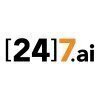


i
Blue
Yonder
Work with us
![]()
Filter interviews by
Blue Yonder React Js Frontend Developer Interview Questions and Answers
Blue Yonder React Js Frontend Developer Interview Experiences
1 interview found
I appeared for an interview in Sep 2024.
(1 Question)
- Q1. 2 simple dsa questions and asked about javascript and react questions
(1 Question)
- Q1. Asked react advance concepts and one machiene coding round
Interview Preparation Tips
What people are saying about Blue Yonder





Interview questions from similar companies

Interview Questionnaire
1 Question
- Q1. Print even and odd numbers using two threads in Java
- Ans.
Printing even and odd numbers using two threads in Java
Create two threads, one for even numbers and one for odd numbers
Use a loop to iterate through the numbers and print them
Use synchronization to ensure alternate printing of even and odd numbers
Use wait() and notify() methods to control the execution of threads
Skills evaluated in this interview

I applied via Approached by Company and was interviewed in Aug 2023. There were 5 interview rounds.

Medium data structure problem was given and asked to solve. System design questions was asked.
Medium data structure problem was asked. Java questions were asked and previous projects were discussed.
(3 Questions)
- Q1. System Design question was asked. Java concepts were asked.
- Q2. Java Concepts were asked.
- Q3. Previous projects were discussed.
(1 Question)
- Q1. Previous projects were discussed. Roles and responsibilities were discussed.
Interview Preparation Tips
- Data Structures
- Algorithms
- System Design
- Java

Senior Software Developer Interview Questions & Answers
Dassault Systemesposted on 8 Jan 2025
(1 Question)
- Q1. All about react

Senior Software Developer Interview Questions & Answers
Dassault Systemesposted on 23 Apr 2025
I appeared for an interview before Apr 2024, where I was asked the following questions.
- Q1. What is the purpose of using a constant reference in a copy constructor in C++?
- Ans.
Using a constant reference in a copy constructor avoids unnecessary copying and ensures the original object remains unchanged.
Efficiency: Passing by constant reference prevents the overhead of copying large objects, improving performance.
Const Correctness: It ensures that the original object cannot be modified, maintaining the integrity of the data.
Syntax Example: In a copy constructor, you might see 'ClassName(const C...
- Q2. What is the mechanism of runtime polymorphism?
- Ans.
Runtime polymorphism allows methods to be invoked at runtime based on the object's type, enabling dynamic method resolution.
Achieved through method overriding in inheritance.
Example: A base class 'Animal' has a method 'sound()', overridden by 'Dog' and 'Cat'.
The method invoked depends on the object type at runtime.
Facilitates code flexibility and reusability.
Commonly used in frameworks and libraries for dynamic behavio...
- Q3. What is the process for creating a custom string class using char* in coding?
- Ans.
Creating a custom string class using char* involves managing memory, constructors, destructors, and operator overloading.
Memory Management: Use dynamic memory allocation (e.g., new and delete) to manage the char* array, ensuring proper allocation and deallocation.
Constructor: Implement a constructor to initialize the string from a char* input, copying the content and allocating necessary memory.
Destructor: Define a des...
- Q4. What is the minimum number of weighings required to identify the person with a different weight among nine individuals, where eight have equal weight and one has a different weight, using a balance scale?
- Q5. What is the method for projecting one vector onto another vector?
- Ans.
Vector projection involves calculating the component of one vector along another using dot products.
The formula for projecting vector A onto vector B is: proj_B(A) = (A · B / B · B) * B.
Here, A · B represents the dot product of vectors A and B.
The result is a vector that points in the direction of B and has a magnitude equal to the component of A in that direction.
Example: If A = (3, 4) and B = (1, 0), then proj_B(A) =...
- Q6. Given the product of the ages of two individuals is a certain number and both individuals are eligible to vote, how can one determine the ages of each individual?

Senior Software Developer Interview Questions & Answers
Thomson Reutersposted on 3 Sep 2022
I applied via Naukri.com and was interviewed in Aug 2022. There were 2 interview rounds.

(1 Question)
- Q1. Core deep concepts of c++ and few basic coding questions
Interview Preparation Tips
Also be precise with your past experience and vocal about the things you've achieved and learnt.

Senior Software Developer Interview Questions & Answers
Amadeusposted on 25 Feb 2022
(2 Questions)
- Q1. Reverse a string without any library function.
- Ans.
Reverse a string without any library function.
Create an empty string to store the reversed string
Loop through the original string from end to start
Append each character to the empty string
Return the reversed string
- Q2. About current project and it's architecture. Challenges you've faced in current project and how did you've solved it. Basic of OOPS
(1 Question)
- Q1. Personality check, tell me something about yourself which is not there in CV
Interview Preparation Tips

I appeared for an interview in Aug 2016.
Interview Preparation Tips
Experience: The questions were tricky. We were given a paragraph and after reading it, a statement was given to us and we were asked to say if it is true, false or cannot say. The structure of the statement put us into a a tough place. So practice of such kind of questions is necessary.
For data interpretation questions a good hand on basic statistical mathematics is needed. One has to be quick because of the time crunch. The questions were approachable
Round: Technical Interview
Experience: In this round my resume was scanned and I was required to speak about myself, my projects and explain certain areas of my resume. The interviewer picked up one of my basic project, surprisingly, and asked me to elaborate on it. He asked me how I can improve the project. And I had to write a code to make that change. Basically, one should have a good idea about the projects they've done/ mentioned in their resume. And know it in detail.
Few questions on data structures. Prepare well for coding type questions and data structures.
Round: Puzzle Interview
Experience: The interviewer asked me two puzzles. They were moderate level. And also luckily he was helpful whenever I got stuck.
Round: HR Interview
Experience: HR round was good. Basic questions like " tell me more about yourself", brief information about my past history, college life, extra curricular activities. In the end she asked me, "should we hire you?" And I lightly answered " why not!" So it was a good interview overall.
Skills: Coding Skills, Team Working Ability, Project management
College Name: Visvesvaraya National Institute Of Technology

Interview Preparation Tips
Skill Tips: Try to be very good at this subject if you are targeting this company. Challenging algorithm questions were also asked but they were not too hard. A fine knowledge of Java could give you an edge over other candidates.
Skills: VmWare mainly focuses on Operating System.
College Name: NIT SURATHKAL

I appeared for an interview before Mar 2021.
(2 Questions)
Round duration - 45 minutes
Round difficulty - Medium
Technical Interview round with questions on DSA.
- Q1.
Reverse Words in a String: Problem Statement
You are given a string of length
N. Your task is to reverse the string word by word. The input may contain multiple spaces between words and may have leading o... - Ans.
Reverse words in a string while handling leading, trailing, and multiple spaces.
Split the input string by spaces to get individual words
Reverse the order of the words
Join the reversed words with a single space in between
Handle leading, trailing, and multiple spaces appropriately
- Q2.
Reverse a Stack Using Recursion
You are given a stack of integers. Your task is to reverse the stack using recursion without using any extra space other than the internal stack space used due to recursion...
- Ans.
Reverse a stack using recursion without using any extra space other than the internal stack space.
Use recursion to pop all elements from the original stack and store them in function call stack.
Once the stack is empty, push the elements back in reverse order.
Base case of recursion should be when the original stack is empty.
(2 Questions)
Round duration - 45 minutes
Round difficulty - Medium
Technical Interview round with questions on DSA.
- Q1.
Convert a Binary Tree to its Mirror Tree
Given a binary tree, convert this binary tree into its mirror tree. A binary tree is a tree in which each parent node has at most two children. The mirror of a bin...
- Ans.
Convert a binary tree to its mirror tree by interchanging left and right children of all non-leaf nodes.
Traverse the binary tree in a recursive manner.
Swap the left and right children of each non-leaf node.
Continue this process until all nodes have been processed.
- Q2.
Remove Nth Node from End of Linked List
You are given a singly linked list with 'N' nodes, each containing integer data, and an integer 'K'. Your goal is to remove the 'K'th node counting from the end of ...
- Ans.
Remove the Kth node from the end of a singly linked list.
Use two pointers approach to find the Kth node from the end.
Handle edge cases like removing the head node or removing the last node.
Update the pointers to remove the Kth node and reconnect the list.
Round duration - 30 minutes
Round difficulty - Easy
Typical Managerial round.
Interview Preparation Tips
Tip 1 : Must do Previously asked Interview as well as Online Test Questions.
Tip 2 : Go through all the previous interview experiences from Codestudio and Leetcode.
Tip 3 : Do at-least 2 good projects and you must know every bit of them.
Tip 1 : Have at-least 2 good projects explained in short with all important points covered.
Tip 2 : Every skill must be mentioned.
Tip 3 : Focus on skills, projects and experiences more.
Skills evaluated in this interview
Blue Yonder Interview FAQs
Tell us how to improve this page.
Blue Yonder Interviews By Designations
- Blue Yonder Senior Software Engineer Interview Questions
- Blue Yonder Software Engineer Interview Questions
- Blue Yonder Lead Software Engineer Interview Questions
- Blue Yonder Support Engineer Interview Questions
- Blue Yonder Associate Software Engineer Interview Questions
- Blue Yonder Support Engineer 1 Interview Questions
- Blue Yonder Technical Support Engineer Interview Questions
- Blue Yonder Business Consultant Interview Questions
- Show more
Interview Questions for Popular Designations
- Software Developer Interview Questions
- Front end Developer Interview Questions
- Web Developer Interview Questions
- Senior Software Developer Interview Questions
- Junior Software Developer Interview Questions
- UI Developer Interview Questions
- Angular Frontend Developer Interview Questions
- Angular Developer Interview Questions
- Show more
Overall Interview Experience Rating
based on 1 interview experience
Difficulty level
Interview Questions from Similar Companies
|
Senior Software Engineer
384
salaries
| ₹18.1 L/yr - ₹32.8 L/yr |
|
Software Engineer
301
salaries
| ₹9.8 L/yr - ₹17 L/yr |
|
Technical Consultant
271
salaries
| ₹6.9 L/yr - ₹21.3 L/yr |
|
Senior Technical Consultant
202
salaries
| ₹16.6 L/yr - ₹30 L/yr |
|
Senior Business Consultant
199
salaries
| ₹18 L/yr - ₹30 L/yr |

SAP

24/7 Customer

Thomson Reuters

Oracle Cerner
- Home >
- Interviews >
- Blue Yonder Interview Questions








